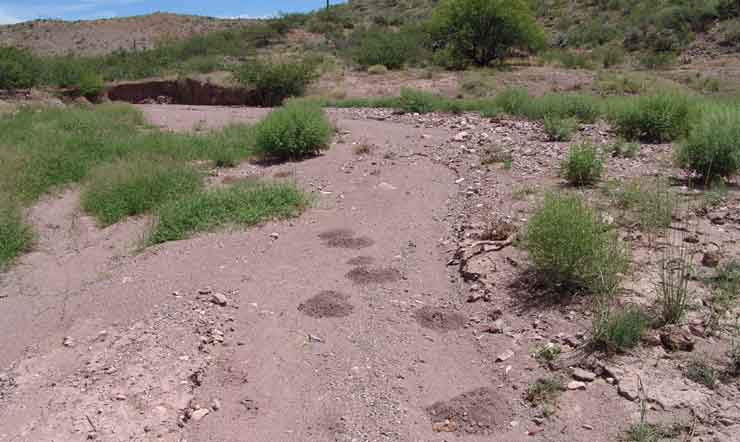
Western Pocket Gopher (Thomomys bottae)
Although we very seldom see our Pocket Gophers (the image above is not from the San Pedro River Valley, and is provided here only for general identification of the species), we know they are fairly numerous in the bottoms of our moister washes and watertanks because we frequently see their characteristic mounds, as illustrated below:

We observed this set of fairly fresh mounds in the delta of the Big Tank in August 2004, following rains and a considerable runoff into the Tank which had left the bottom of the Tank still muddy with tiny young Sonoran Toads hopping about. These mounds were well above the muddy portion and not as fresh as they look from a distance but were somewhat eroded by wind etc. Pocket Gopher Mounds have a characteristic "plug" left at the top of the fan-shaped mound of earth, as shown in this single example below, photographed in January 2005 at the confluence of Sierra Blanca Spring Wash with Sierra Blanca Canyon Wash (Click on each image to enlarge it)
 ..
..
This plug marks the point of closure of the mound's tunnel opening. The photo at left was taken early in the day, and looked fresh and damp, on the right in the afternoon, surface now dried out.
All pocket gophers have short legs, stout, thickset bodies with little evidence of a neck, nearly naked tails (always shorter than head and body), small eyes and ears, are about 91/2 inches long and weigh up to half a pound. Their large incisor teeth are always exposed. They occupy locations where soils are easily dug, so are found mainly in our floodplains, where their fan-shaped mounds of earth reveal their presence. They eat a wide range of vegetable foods (storing food in external, fur-lined cheek pouches), and are rarely seen but remain inside their extensive tunnel systems (which include storage, latrine, and nesting chambers). They are mainly solitary creatures. Merlin (in mammal page sources, p. 496) lists 3 species for the Sonoran Desert.
Hoffmeister (1986, pp. 219-246) provides the most detailed study of the Pocket Gophers of Arizona, observing that Thomonys bottae are by far the most commonly encountered, being found "in nearly every habitat within the state so long as sufficient tuberous roots and plant material are available and soil is suitable for digging tunnels. They are to be found near sea level as at Yuma to 11,000 feet on Mt. Baldy. They live in extremely xeric places such as the Yuma desert... through all of the vegetative types to near timberline in the White and San Francisco Mountains." (p. 223) Since they tend to live in confined areas and are solitary in habit, different populations tend to become isolated and Hoffmeister estimates that as many as 50 varieties of this species may eventually be distinguished.
Since at present we have no photographs of our local Botta's Pocket Gopher, and since this species is found throughout the state, we strongly suspect that both our local ones and those found at the top of the Catalina Mountains are fellow members, though no doubt different varieties. Since we do have some fair pictures of a Pocket Gopher photographed near the top of Mt. Lemmon in August 2007, we present several images of that animal here below, both to indicate general Pocket Gopher appearance and to lay a basis for comparison when we do manage to photograph some local specimens: (Click on each image to enlarge it)
 .
. .
. .
.
Viewing the enlarged images from left to right, at far left you can see the whole length of the gopher, including a glimpse of its rather short tail at lower left and also of its small right foot. This image also gives a sense of the color ranges of the fur across the length of the animal. At mid-left you see the eyes, rich array of sensory whiskers, and both external cheek pouches as it stuffs a dry stalk of grass into its mouth. A glimpse of the long sharp claws of the left paw is also feasible. At mid-right the main objects visible are two long pointed claws of the right forepaw, which is covered with gray fur. At far right, see a good view of eyes, ears, and the claws of the left fore-paw holding a green grass stalk being rapidly ingested. In this photo the large external cheek pouches are also clearly visible. (We failed to capture an image of the large incisors of this rodent, but one of us did clearly see them while all four of us watched this gopher's antics. It remained nearly oblivious to our movements around its multi-chambered den as it repeatedly emerged to seize long stalks of grass and then tug them all the way back inside.)
Back to Rodents